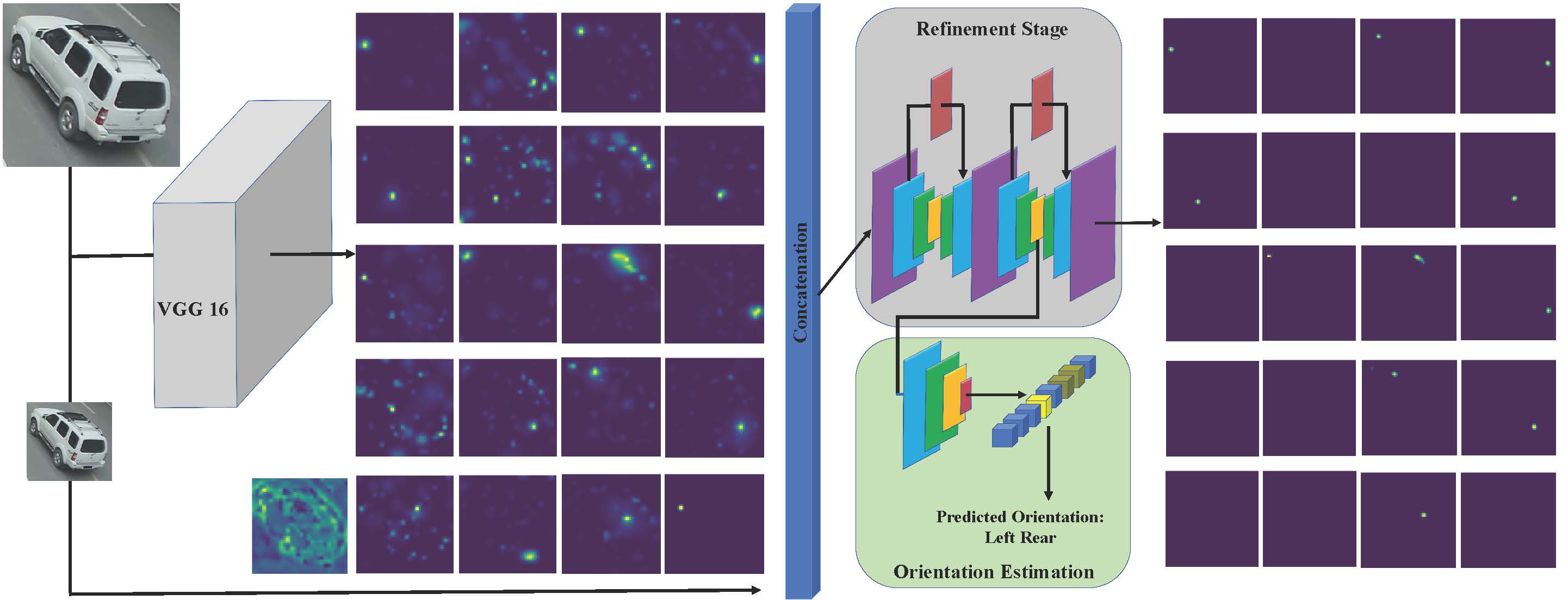The repository contains the code for vehicle key-point and Orientation estimation Network proposed in the A Dual Path Model With Adaptive Attention For Vehicle Re-Identification which has been accepted as an oral presentation in ICCV 2019. The code for re-identification network does not exist in the repository.
The code for vehicle key-point and orientation estimation has been released to facilitate future research in vehicle alignment, 3d vehicle modeling and vehicle speed estimation.
The figure below demonstrates the pipeline for prediction of 20 vehicle landmarks and classify vehicle's orientation into one of 8 classes all defined in here.
Key-point estimation is done in two stages; in stage 1 the model tries to come up with coarse estimation of key-points location and in stage 2 those coarse estimates are refined through an hourglass like structure and in a parallel branch the orientation of the vehicle is predicted as well.
Clone this repository with the following command:
git clone https://github.com/Pirazh/Vehicle_Key_Point_Orientation_Estimation
The code is written in Python 2.7 with Pytorch version "0.4.1". To install the dependencies run the following command:
pip install -r requirements.txt
Then you have to download and put the pre-trained model and Veri-776 dataset in the following directories:
-
Put the
VeRifolder containing the dataset into./data/. You can alternatively change the paths in the./tools/paths.pyaccording to your preference. -
Download the pre-trained stage1 & stage2 Key-point models from here and here and put them in
./checkpoints/stage1/and./checkpoints/stage2/directories.
To test an already trained model, you have to specify the test phase, stage1(Coarse key-points estimation)/stage2(Entire model for fine key-points generation and orientation estimation) use cases and the path to the trained model. This can be achieved by running the following command:
python main.py --phase test --use_case stage1 --resumed_ckpt PATH_TO_STAGE1_PRE_TRAINED_MODEL
python main.py --phase test --use_case stage2 --resumed_ckpt PATH_TO_STAGE2_PRE_TRAINED_MODEL
The number of workers, train/test batch size can be set through arguments --num_workers, --train_batch_size, --test_batch_size. The code also has multi GPU training/testing support which is enabled by passing --mGPU argument in the main.py script. If you wish to visualize the predicted key-points, you can do so by passing the --visualize argument.
To train stage1 of the model run the following command:
python main.py --phase train --use_case stage1 --mGPU --lr 0.0001 --epochs 15
After training, results can be found in ./checkpoints/stage1/TIME_STAMP_STAMP_WHEN_TRAINING_STARTED.
To train the entire model run the followning:
python main.py --phase train --use_case stage2 --mGPU --lr 0.0001 --epochs 15 --stage1_ckpt PATH_TO_THE_STAGE1_TRAINED_MODEL
Training results can be found in ./checkpoints/stage2/TIME_STAMP_WHEN_TRAINING_STARTED.
| Stage1 | Stage2 | |
|---|---|---|
| Key-Point localization MSE (pixels) | 1.95 | 1.56 |
| Orientation Classification Accuracy | - | 84.44% |
Note that the localization MSE is calculated in 56 * 56 heatmaps. The following figure is the confusion matrix for the vehicle orientation estimation. In most of the cases the network classifies the orientation correctly; however in some cases since there is no clear boundry between defined orientation classes e.g. left front and left, the network struggles the in determining the correct class.
If you find this repository useful in your research please cite our paper:
@InProceedings{Khorramshahi_2019_ICCV,
author = {Khorramshahi, Pirazh and Kumar, Amit and Peri, Neehar and Rambhatla, Sai Saketh and Chen, Jun-Cheng and Chellappa, Rama},
title = {A Dual-Path Model With Adaptive Attention for Vehicle Re-Identification},
booktitle = {The IEEE International Conference on Computer Vision (ICCV)},
month = {October},
year = {2019}
}
If you have any questions regarding the model and the repository send me an email at (pkhorram@terpmail.umd.edu).

